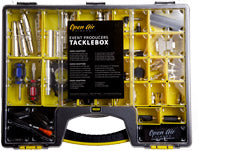How to Calculate Throw Distance

Light may travel quickly, but it doesn't always travel as far as you'd like it to. This is especially true in the outdoor cinema game. The lens in your projector is calibrated to push the illuminated image only out to a certain distance; any closer or farther and the image becomes distorted, faded, stretched out, et cetera. When you're using your projector to play movies at different outdoor cinema events, it's tough to get the projector positioned correctly the first time. You won't always be working with the same size of screen and the physical constraints of your venue will always be subject to change. That's why in this post we're going to talk about some easy ways to figure out your throw ratio when you're out in the field.
Read the Manual
Yeah, okay, Captain Obvious. Reading the manual sounds like the end answer to this problem, but it's really the beginning. Your projector's manufacturer will let you know exactly what the throw ratio is. You'll see a number, followed by a colon and then another number, like, 1.5:1.The first number represents 1.5 feet of distance from the projector to the screen. The number after the colon represents 1 foot of screen width. In this example, the throw ratio would tell you that for every 1 foot of screen width, you want to move your projector 1.5 feet away from the screen.
Measuring Throw Distance
Now comes the time for application. Let's say you're setting up an outdoor cinema event and your projector has a throw ratio of 1.3:1.The screen that you're using for tonight's event is 10 feet. How far back should the projector sit from the screen? Let's do the math and find out. Take the width of the screen and multiply it by the first number in the throw ratio, 1.3. It should look like this:
10 (width of screen) x 1.3 (throw ratio) = 13
According to this equation, if you set your projector thirteen feet back from the screen, your picture will be perfectly illuminated and will easily fit the proportions of the screen with some minor adjustments to the lens' zoom.Why It's Important
When it comes to good projection, positioning is everything. But, sometimes the constraints of our venue don't always fall in our line with our projector's innate capabilities.For example, let's say you've got a projector whose throw ratio is 1.2:1 and you've got a screen that is 16 feet wide. Normally, 19.2 feet is the farthest away you could set the projector before the image begins to distort.
But, let's say you're setting up at a large outdoor amphitheater and you've got to set the projector further back so that it doesn't clog up the aisles and create a fire hazard. Well, in this case you would need to switch out your lens for something that has a longer throw (note that not all the projectors have interchangeable lenses). It's actually a simple solution. But, without knowing about throw ratio and throw distance, you wouldn't know how to handle the image distortion that would come about in this situation.
Be sure to keep a tape measure in your gear bag at all times, so that you can properly measure the width of your screen and the distance your projector must sit at from the screen. Being able to measure throw distance down to the inch will lend you a crisp, clear picture, and your outdoor cinema event will stand out from the rest for it.





